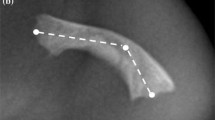Abstract
Background
The “coat-hanger” sign of the ribs with a bell-shaped thorax has been known as a radiological hallmark of the paternal uniparental disomy 14 (upd(14)pat).
Objective
To quantitatively determine the differences in thoracic deformity between upd(14)pat and other bone diseases with thoracic hypoplasia and to establish the age-dependent evolution.
Materials and methods
The subjects comprised 11 children with upd(14)pat. The angle between the 6th posterior rib and the horizontal axis was measured (coat hanger angle; CHA). The ratio of the mid- to widest thorax diameter (M/W ratio) was calculated for the bell-shaped thorax.
Results
CHA ranged from +28.5 to 45° (mean; 35.1° ± 5.2) in upd(14)pat, and from −19.8 to 21° (−3.3 ± 13°) in bone dysplasias (p < 0.01). The M/W ratio ranged from 58% to 93% (75.4 ± 10) in upd(14)pat, and from 80% to 92% (86.8 ± 3.3) in bone dysplasias (p < 0.05). Serial radiographs revealed that CHA remained constant during early childhood, while the M/W ratio gradually increased with age.
Conclusion
The “coat-hanger” sign of upd(14)pat provides a distinctive radiological gestalt that makes it possible to differentiate the disorder from other skeletal dysplasias. By contrast, the bell-shaped thorax is significant only in the neonatal period.







Similar content being viewed by others

References
Kotzot D (2004) Advanced parental age in maternal uniparental disomy (UPD): implication for the mechanism of formation. Eur J Hum Genet 12:343–346
Towner D, Yang SP, Shaffer G (2001) Prenatal ultrasound findings in a fetus with paternal uniparental disomy 14q12-qter. Ultrasound Obstet Gynecol 18:268–271
Offiah AC, Cornette L, Hall CM (2003) Paternal uniparental disomy 14: introducing the “coat-hanger” sign. Pediatr Radiol 33:509–512
Stevenson DA, Brothman AR, Chen Z et al (2004) Paternal uniparental disomy of chromosome 14: confirmation of a clinically-recognizable phenotype. Am J Med Genet A 130A:88–91
Kagami M, Nishimura G, Okuyama T et al (2005) Segmental and full paternal isodisomy for chromosome 14 in three patients: narrowing the critical region and implication for the clinical feature. Am J Med Genet A 138A:127–132
Kurosawa K, Sasaki H, Yamanaka M et al (2002) Paternal UPD 14 is responsible for a distinctive malformation complex. Am J Med Genet 110:268–272
Yamanaka M, Ishikawa H, Saito K et al (2010) Prenatal findings of paternal uniparental disomy 14: report of four patients. Am J Med Genet 152A:789–791
Sutton VR, McAlister WH, Bertin TK et al (2003) Skeletal defect in paternal uniparental disomy for chromosome 14 are re-capitulated in the mouse model (paternal uniparental disomy 12). Hum Genet 113:447–451
Mattes J, Whitehead B, Liehr T et al (2007) Paternal uniparental isodisomy for chromosome 14 with mosaicism for a supernumerary marker chromosome 14. Am J Med Genet 143A:2165–2171
Irving MD, Bulting K, Kanber D et al (2010) Segmental paternal uniparental disomy (patUPD) of 14q32 with abnormal methylation elicites the characteristic features of complete pat UPD14. Am J Med Genet 152A:1942–1950
Georgiades P, Watkins M, Surani MA et al (2000) Parental origin-specific developmental defects in mice with uniparental disomy for chromosome 12. Development 127:4719–4728
Kagami M, Sekita Y, Nishimura G et al (2008) Deletions and epimutations affecting the human 14q32.2 imprinted region in individuals with paternal and maternal upd(14)-like phenotypes. Nat Genet 40:237–242
Spranger JW (2002) Asphyxiating thoracic dysplasia. In: Spranger JW, Brill PW, Poznanski A (eds) Bone dysplasia, an atlas of genetic disorders of skeletal development, 2nd edn. Oxford University Press, New York, pp 125–129
Swischuk LW (2004) Chapter 1. Respiratory system; respiratory distress in the newborn. In: Swischuk LE (ed) Imaging of the newborn, infant, and young child, 5th edn. Lippincott, Williams & Wilkins, Philadelphia, pp 29–36
Cotter PD, Kaffe S, McCurdy LD et al (1997) Paternal uniparental disomy for chromosome 14: a case report and review. Am J Med Genet 70:74–79
Author information
Authors and Affiliations
Corresponding author
Rights and permissions
About this article
Cite this article
Miyazaki, O., Nishimura, G., Kagami, M. et al. Radiological evaluation of dysmorphic thorax of paternal uniparental disomy 14. Pediatr Radiol 41, 1013–1019 (2011). https://doi.org/10.1007/s00247-011-2132-1
Received:
Revised:
Accepted:
Published:
Issue Date:
DOI: https://doi.org/10.1007/s00247-011-2132-1



